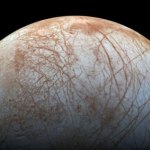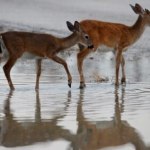15 February 2023
Quaoar is a minor planet orbiting the sun beyond Pluto. It is named after a god of creation in Native American mythology. And it is creating some surprises for astronomers as it orbits in the cold outer parts of our solar system.
Researchers said recently that they have found a ring surrounding Quaoar similar to the one around the planet Saturn. But the ring around Quaoar differs from the current understanding of where rings can form. It is located much further away from it than current scientific understanding would permit.
The distance of the ring from Quaoar places it in a place where scientists believe particles should come together around a planet to form a moon, rather than a ring.

An illustration showing the frigid distant world Quaoar, orbiting in our solar system beyond Pluto, surrounded by its newly discovered ring, along with its moon Weywot. (ESA, CC BY-SA 3.0 IGO/Handout via REUTERS)
"This is the discovery of a ring located in a place that should not be possible," said Bruno Morgado. He is an astronomer with the Valongo Observatory at the Federal University of Rio de Janeiro in Brazil. He is the lead writer of the study published in Nature.
Discovered in 2002, Quaoar is currently defined as a minor planet. Some scientists are proposing to call it a dwarf planet. But it has not yet been officially given that name by the International Astronomical Union, the scientific group that names astronomy objects.
Quaoar is about 1,110 kilometers across, which is about one third the size of Earth's moon. But the minor planet is about half the size of the dwarf planet Pluto. Quaoar has a small moon called Weywot, Quaoar's son in mythology. It has a diameter of 170 kilometers and orbits beyond the ring.
Quaoar is in a distant part of the Solar System called the Kuiper belt, which contains many icy bodies. It orbits about 43 times the distance from the sun to the Earth. Neptune, the most distant planet from the sun, orbits at about 30 times the Earth-to-sun distance.
Quaoar's ring was discovered using the European Space Agency's orbiting CHEOPS telescope. The telescope's main use is to study planets beyond our solar system.
The ring is a disk made of ice-covered particles. It is about 4,100 kilometers away from Quaoar's center. It has a diameter of about 8,200 kilometers.
Unlike any other known rings around bodies in space, Quaoar's ring is outside what is called the Roche limit. That is the distance from any celestial body where it gravitational force would cause an approaching object to be pulled apart. Material orbiting outside the Roche limit would be expected to become a moon.
Saturn has the largest ring system in our solar system. The other large gas planets - Jupiter, Uranus and Neptune - all have rings, but not as big. Other non-planetary bodies, Chariklo and Haumea, also have rings. All are inside the Roche limit.
Why is Quaoar's ring outside the Roche limit?
Isabella Pagano is with the Astrophysical Observatory of Catania and one of the study's writers. She said rings could form from debris when the body was formed, or when something collided with the minor planet or another body.
But: "We do not have hints at the moment on how the Quaoar ring formed," Pagano said.
She added that the science on how large bodies like moons are created might "need to be revised."
I'm Dan Novak.
Dan Novak adapted this story for VOA Learning English based on reporting by Reuters.
______
Words in This Story
astronomer — n. a scientist who studies objects in space
ring –n. a circular object with nothing in the middle
locate –v. to be in a place
dwarf — adj. something that is smaller than normal
debris — n. what is left after something is destroyed
collide — v. the action of two (or more) objects crashing into each other
hint — n. a suggestion or information that can help answer a question
revise — v. to update something with new information, to correct or improve something











